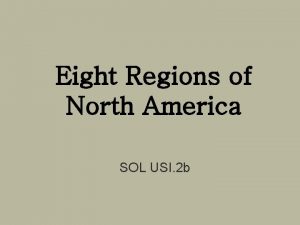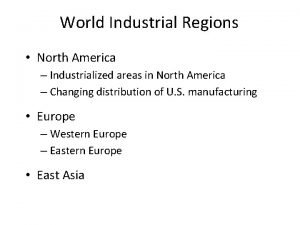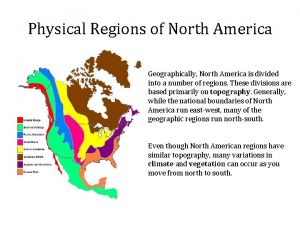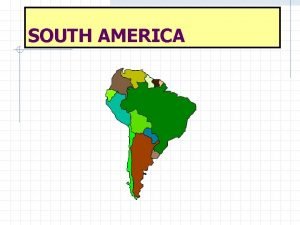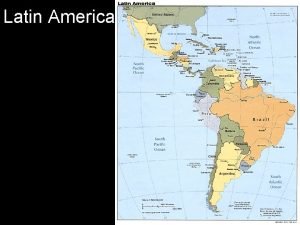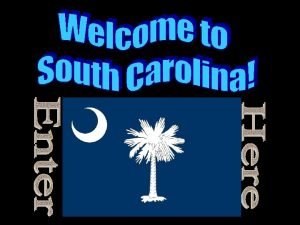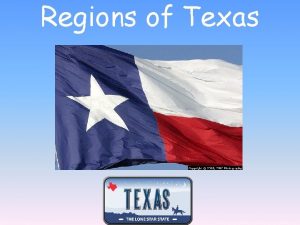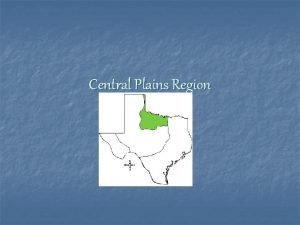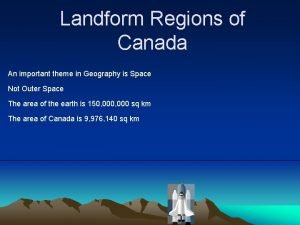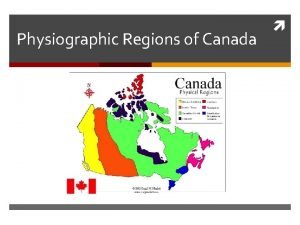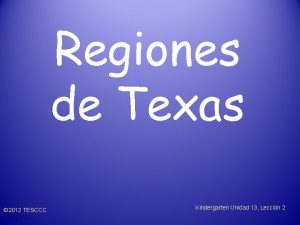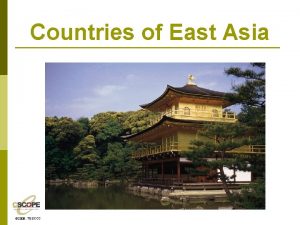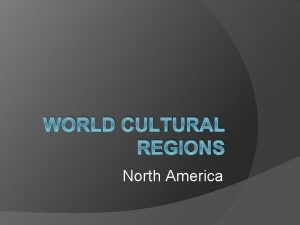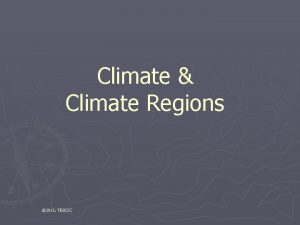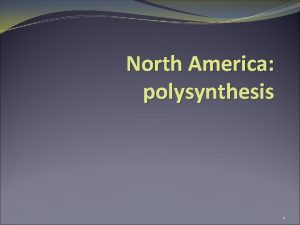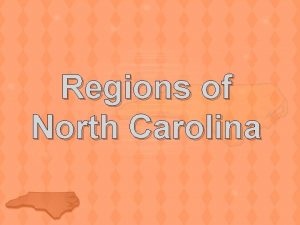Regions of North America Canada 2012 TESCCC Canada











- Slides: 11

Regions of North America: Canada © 2012, TESCCC

Canada Made up of ten provinces and three Territories. n 2 nd largest country in land area. n Largest block of population settled in the southeast near the valley of the St. Lawrence Seaway. n More than 5, 000 miles (8, 050 km) of border with the US, which is generally open and allows easy cultural and economic connections between the populations on both sides of the boundary. n © 2012, TESCCC

Regions of Canada n Maritime Atlantic Provinces- Nova Scotia, New Brunswick, Prince Edwards Island, and Newfoundland. Core – Quebec and Ontario (Includes French Canada n Prairie Provinces – Manitoba, Saskatchewan, and Alberta n Western Province. British Columbia n Northern Frontier- Nunavut, Northwest Territory, Yukon n © 2012, TESCCC

Physical Geography Physical Features: n What physical features of Canada are shared with the U. S. ? • Canadian Shield • Arctic Coastal Plain • Central Lowlands • Great Plains • Rocky Mountains • Intermontane Basins • Coastal Ranges © 2012, TESCCC

Climate Descriptions n n n Humid Continental (short summers) along the southern border of Canada Steppe climate in the Prairie Provinces Highland climate in the Rockies Marine West Coast (along British Columbia) Subarctic (interior north of Canada) Tundra- Northern fringes © 2012, TESCCC

Population Geography of Canada n About ninety percent of Canada’s population lives within 100 miles (161 km) of the US-Canadian border. n One-third of Canada’s population lives in Toronto, Montreal and Vancouver. n Chief trading partner of the US (source of US energy imports) © 2012, TESCCC

Maritime or Atlantic Provinces Atlantic Canada - consists of the provinces of Newfoundland, New Brunswick, Nova Scotia, and Prince Edward Island n Cod fishing - mainstay of its economy ever since earliest settlement n The Grand Banks - east of this region, have long been a rich source of fish harvest because of the mixing of warm waters from the south and cold from the north. n Recently, the Banks have become so over-fished that they have lost their capacity to support the region's fishing population. n © 2012, TESCCC

Core Provinces Ontario and Quebec - the two provinces which make up the core of Canadian settlement and political influence. n Two-thirds of Canada's population lives in this region. n The margins of the St. Lawrence River and the Great Lakes make up the areas of primary settlement and industrial activity. n Ontario- strongly British, and Quebec is powerfully French in its cultural flavor, with 80% of the Quebec population of French origin. n © 2012, TESCCC

Prairie Provinces Prairie region - made up of Manitoba, Saskatchewan, and Alberta. – Wheat, petroleum, and coal - major economic resources n Major urban centers include Edmonton, Calgary, and Winnipeg. These centers provide linkage east and west with other major Canadian regions and also to the North. n © 2012, TESCCC

Western Province Western Frontier - centered in Vancouver, British Columbia, at the mouth of the Fraser River. n More than one-half of the province's population lives in the Vancouver area, which is the region's main industrial, administrative, financial, and cultural center. n Vancouver is home to the second largest Chinatown in North America. n Shares many of the same characteristics at the Pacific Northwest of the U. S. n © 2012, TESCCC

Northern Frontier: Territories n Canadian North – sparsely populated – Nickel, copper, and uranium are the major resource metals mined and exported from the area. – Forestry, pulp manufacture, and hydroelectricity - additional economic resources n Nunavut is the newest political unit. (1999) © 2012, TESCCC
 Tesccc
Tesccc The eight regions of north america
The eight regions of north america Industrial regions of north america
Industrial regions of north america 8 physical regions of north america
8 physical regions of north america America vs africa
America vs africa South america map regions
South america map regions Much of latin america lies between
Much of latin america lies between South carolina regions
South carolina regions How many regions are in texas?
How many regions are in texas? Subregions of the north central plains
Subregions of the north central plains How were the appalachians formed
How were the appalachians formed Physiographic regions of canada
Physiographic regions of canada

